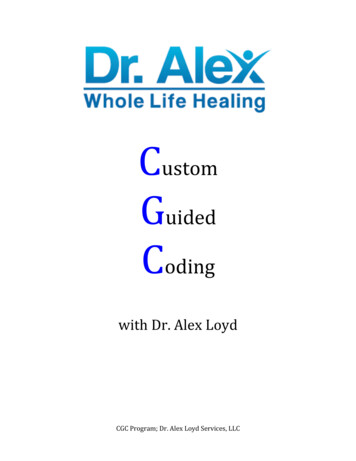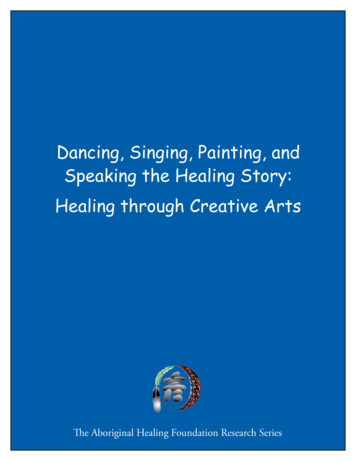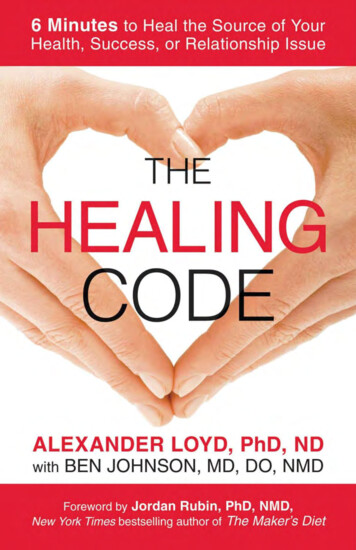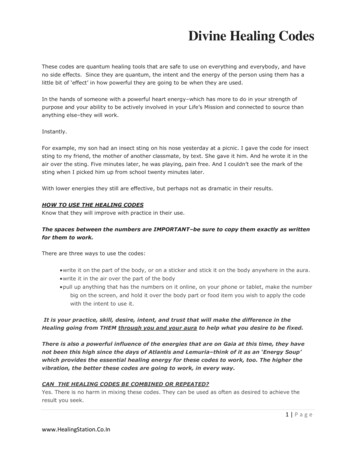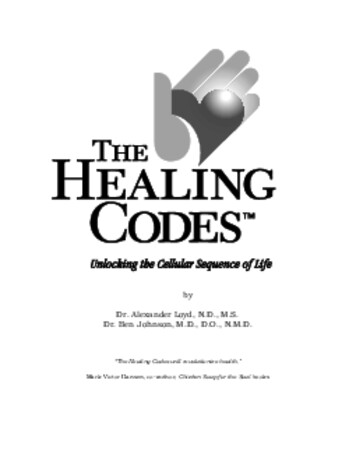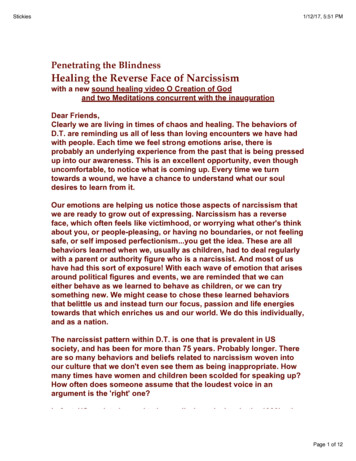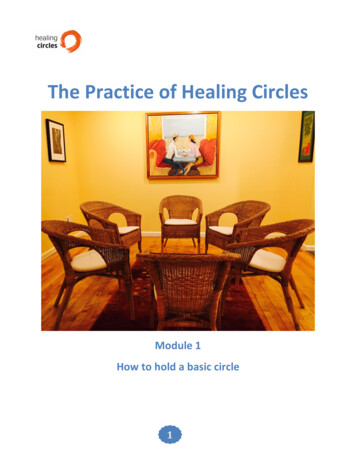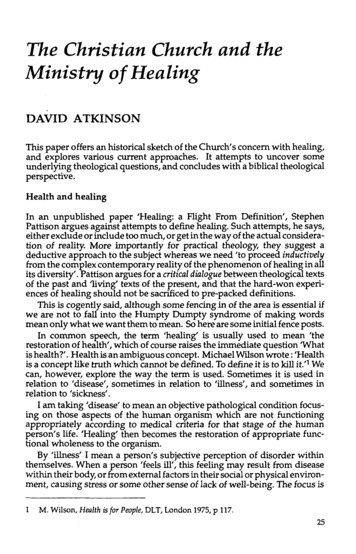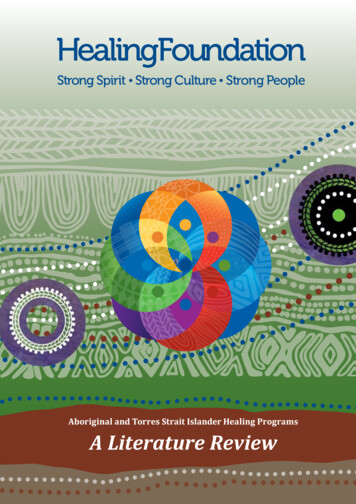
Transcription
Aboriginal andTorres Strait IslanderHealing ProgramsA LiteratureReviewAuthorsJane McKendrick, Robert Brooks, Jeffrey Hudson, Marjorie Thorpe, Pamela BennettAcknowledgementsKelleigh Ryan, Alma Thorpe, Britt Romani, Regina Jagiellopage 1
Defining our healing: a literature reviewExecutive SummaryThis review summarises existing research on healing internationally and nationally, highlighting what constitutes an effectiveAboriginal and Torres Strait Islander healing process. This evidence enables the identification of what constitutes an effectivehealing program and the gaps in our knowledge that can inform future evaluation and research priorities.The literature revealed that to be successful, a healing program needs to be created within the local context; respond to needsidentified by local community members and be supported by the local community. Sustainability needs to be multi-level andinclude development and transfer of knowledge and resources. This includes strong evaluation frameworks that are consistentwith an Aboriginal and Torres Strait Islander world view.The literature review has provided an inter-country context for healing that clearly demonstrates what constitutes an effectivehealing program; the interface between healing and health and the need for quality evaluations that incorporate Aboriginalknowledge systems. The depth of this material enables the Healing Foundation to identify a clear pathway to building anddeveloping the evidence of healing into the future.BackgroundColonisation has had a profound impact on Aboriginal and Torres Strait Islander peoples resulting in unresolved trauma, whichcontinues to be passed down through the generations. This is seen in community through lives marked by poverty, lack ofeducational opportunity, unemployment, poor health, shorter life expectancy, lack of access to services, racial discrimination,and ongoing marginalisation.Aboriginal and Torres Strait Islander communities are healing themselves through the incorporation of traditional practices andaspects of western methodologies in healing programs.Effective healing programsEffective healing programs show positive impacts on individuals, families and communities in terms of self-worth and identity.The evidence in this review demonstrates that these have had a positive impact on health status and health disparities(Wallerstein 2006). There are also positive impacts in terms of knowledge and skills acquisition by community members and thedevelopment of individual, family and community capacity.To be most effective healing programs must be sustainable from the beginning. This is achieved by ensuring there is intra- andextra-community capacity, that intra- and extra- community networks are in place, and that there are adequate resources andfunding provided to enable long term support.Consistent evidence of the characteristics that result in effective healing programs are those: developed to address issues in their local community driven by local leadership based upon well-developed evidence and theory base combining both western methodologies and traditional healing in their treatment theory base informed about and understand the impact of colonisation and intergenerational trauma and grief building upon individual, family and community capacity through the acquisition of knowledge and skills incorporating strong evaluation frameworks With a proactive rather than reactive focuspage 2
ATSI Literature ReviewHealing programs and Aboriginal and Torres Strait Islander systems of healthAchieving optimal conditions for Aboriginal and Torres Strait Islander health and wellbeing requires a holistic and whole-oflife view. This must consider the social, emotional, cultural, spiritual and physical wellbeing of the whole community. This is incontrast to Western medical systems which have a focus on the individual and are disease focused.Indigenous healing programs from the United States of America, Canada and New Zealand have more in common with eachother than with western health programs. All draw on elements of their Indigenous cultures including the underpinning valuesand concepts, traditional Indigenous healing practices and the essence of what it means to live a ‘good’ life.Common aims of the healing programs include increasing social and cultural identity and self-esteem, cultural knowledge andskills and cultural connectedness. The focus of the programs is not limited to the individual but extends more widely to thefamily and the community, with community ownership of programs and building of community capacity.Evaluation of the efficacy of Aboriginal and Torres Strait Islander healing programsTheorists and practitioners agree that current clinical and biomedical methods are not appropriate for the evaluation ofcommunity based healing programs, and this is supported by the literature pertaining to community based primary preventionprograms. The most common method used is participatory action research (PAR) which values the knowledge systems of thecommunity in which the program is conducted. Unfortunately rejection of the biomedical model and case control studies ofefficacy raises some issues around acceptance of the findings of the PAR evaluations.Despite the debate about methodology of evaluation, the findings of evaluations using methods grounded in local Indigenousknowledge together with participatory action research and other qualitative methods are remarkably consistent acrossprograms, tribal groups and countries, making them difficult to reject. Similarly the factors found to be associated with successfulhealing programs are similarly consistent across contexts.There is still a need for ongoing development of new methods for the assessment of the efficacy of healing programs. It isrecommended that innovative methods of evaluation be developed to assess early and intermediate success of healing. Thesemethods should incorporate: a range of definitions of efficacy a range of methodological approaches local social and cultural processes of decision making communities developing their own indicators of success sensitive measures of efficacy such as subjective attitudinal and behavioural changes. Such changes are subtle and occurover time and are not be detected by the relatively coarse clinical measures of efficacy currently available.If Aboriginal and Torres Strait Islander people are to have access to best practice healing programs further research is imperative.This is evident in the areas of the sustainability of the programs, the transferability of knowledge, and the adaption of programssuccessful in one locality to other regions. Methodological development is also urgently required using both Aboriginal andTorres Strait Islander and Western knowledge.The futureThe development of healing centres is emerging as an important approach towards addressing the healing needs of Aboriginaland Torres Strait Islander communities. In the evaluation of the Canadian Aboriginal Healing Foundation, healing centreswere shown as one of the most effective investments towards positive outcomes for those suffering from the impact ofintergenerational trauma and grief. Experts in the field of mental health and wellbeing are calling for an investment in healingcentres in Australia. These investments would seek to address the social and emotional wellbeing needs of Aboriginal andTorres Strait Islander peoples.page 3
The evidence presented in this critical review of the literature pertaining to Indigenous healing and healing programs indicatesthat the establishment of community based Indigenous healing programs/centres established according to the principlesdiscussed would have positive outcomes for Aboriginal and Torres Strait islander people, families and communities.Aboriginal and Torres Strait Islander communities are looking for ways to facilitate individual and community healing. At presentthere is insufficient infrastructure and investment in programmatic design to allow communities to establish effective longterm programs/centres. The emergence of adequately resourced healing centres within the Australian context would enablecommunities to develop healing and social emotional well being responses driven from Aboriginal and Torres Strait Islanderworld views.ConclusionThis review points to: the importance of long term sustainable funding for healing the development of effective evaluation strategies and methodologies as critical to understanding what works and thelong term impact of healing the need for quality programmatic design and theories to guide and develop healing work nationallyThis review creates a framework for change by contributing to:1) the evidence base for healing;2) program logic development;3) principles and resources needed to establish viable healing programs;4) guidelines for business development of healing programs and5) the development of methods of evaluation to assist communities across Australia to build on their knowledge base inthis area and use this knowledge to address issues pertaining to program operation.This work will assist the Healing Foundation and others to assist communities create quality healing environments that achievelong term change for individuals, families and communities, including quality systems required to support healing activities.page 4
ATSI Literature ReviewAboriginal and Torres Strait Islander Healing ProgramsA Literature ReviewContentsAuthors . 1Acknowledgements . 1EXECUTIVE SUMMARY . 2CHAPTER ONE: BACKGROUND9INTRODUCTION . 9COLONISATION, HISTORICAL TRAUMA AND THE RELATIONSHIP TO WELLBEING .10Australia . 11Colonisation, historical trauma and loss and grief . 11The present day – loss and grief.12Indigenous views of mental health and wellbeing.13Towards healing .13Healing methods .13Traditional healing .14Blended healing .14Canada and the United States .14Colonisation, historical trauma and loss and grief .14The present day – loss and grief .15Indigenous views of mental health and wellbeing .16Towards healing .17Healing approaches developed .18Traditional healing .18Blended healing methods .19New Zealand . 21Colonisation, historical trauma and loss and grief . 21History prior to colonisation . 21The present day . 21Different views of health and illness . 22Healing . 22CHAPTER TWO: HEALING PRACTICES AND PROGRAMS – CANADA, THE UNITED STATES AND NEW ZEALAND 24INTRODUCTION . 24CANADA AND THE UNITED STATES . 24The Lodge . 25The context . 25Program description . 25Healing modalities . 25page 5
Impact . . . 26The Lodge: lessons learnt . 26Target group: . 26Healing: . . 26Key tools: . 26Impact: . . 27Traditional healers and telepsychiatry. 26The context . 26Program description . 26Healing modalities . 27Impact . . . 27Traditional healers and telepsychiatry: lessons learnt . . . 27Target group: . 27Healing: . . 27Key tools: . 27Impact: . . 27Medicine House and the Forensic Centre . 27The context . 27Program description . 28Healing modalities . 29Impact . . . 29Medicine House and the Forensic Centre: lessons learnt . . 29Target group: . 29Healing: . . 29Key tools: . 29Impact: . . 29Youth Initiative Project .30The context . 30Program description . 30Healing approach . . 30Impact . . . 31Youth Initiative Project: lessons learnt . . . 32Target group: . 32Healing: . . 32Key tools: . 32Impact: . . 32Building a Nation healing program . 32The context . 32Program description . 32Healing modalities . 33Impact . . . 33Building a Nation program: lessons learnt . 34Target group: . 34Healing: . . 34Key tools: . 34Impact: . . 34A Nunavut case study – healing in an Inuit community . 34The context . 34Program description . 34The healing model . 35Impact . . . 35page 6
ATSI Literature ReviewA healing in an Inuit community: lessons learnt . . . 35Target gr
Aboriginal and Torres Strait Islander communities are healing themselves through the incorporation of traditional practices and aspects of western methodologies in healing programs. Effective healing programs Effective healing programs show positive impacts on individuals, families and communities in terms of self-worth and identity.

